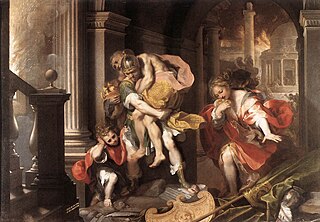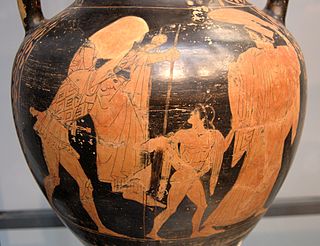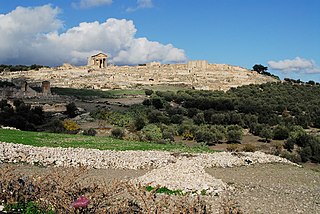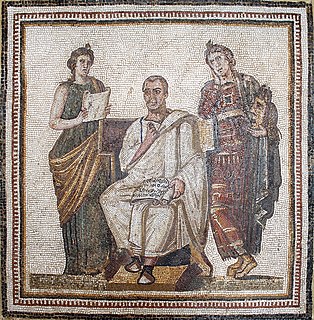
The Aeneid is a Latin epic poem, written by Virgil between 29 and 19 BC, that tells the legendary story of Aeneas, a Trojan who travelled to Italy, where he became the ancestor of the Romans. It comprises 9,896 lines in dactylic hexameter. The first six of the poem's twelve books tell the story of Aeneas's wanderings from Troy to Italy, and the poem's second half tells of the Trojans' ultimately victorious war upon the Latins, under whose name Aeneas and his Trojan followers are destined to be subsumed.

The Third Punic War was the third and last of the Punic Wars fought between Carthage and Rome, and lasted from 149 to 146 BC. The war was fought entirely within Carthaginian territory, in modern northern Tunisia. When the Second Punic War ended in 201 BC, one of the terms of the peace treaty prohibited Carthage from waging war without Rome's permission. Rome's ally, King Masinissa of Numidia, exploited this to repeatedly raid and seize Carthaginian territory with impunity. In 149 BC Carthage sent an army, under Hasdrubal, against Masinissa, the treaty notwithstanding. The campaign ended in disaster as the Battle of Oroscopa ended with a Carthaginian defeat and the surrender of the Carthaginian army. Anti-Carthaginian factions in Rome used the illicit military action as a pretext to prepare a punitive expedition.

Ascanius was a legendary king of Alba Longa and is the son of the Trojan hero Aeneas and Creusa, daughter of Priam. He is a character in Roman mythology, and has a divine lineage, being the son of Aeneas, who is the son of the goddess Venus and the hero Anchises, a relative of the king Priam; thus Ascanius has divine ascendents by both parents, being descendants of god Jupiter and Dardanus. He is also an ancestor of Romulus, Remus and the Gens Julia. Together with his father, he is a major character in Virgil's Aeneid, and he is depicted as one of the founders of the Roman race.

The Siege of Carthage was the main engagement of the Third Punic War and was fought between Carthage and Rome. It consisted of the nearly-three-year siege of the Carthaginian capital, Carthage. In 149 BC a large Roman army landed at Utica in North Africa. The Carthaginians hoped to appease the Romans, but despite the Carthaginians surrendering all of their weapons, the Romans pressed on to besiege the city of Carthage. The Roman campaign suffered repeated setbacks through 149 BC, only alleviated by Scipio Aemilianus, a middle-ranking officer, distinguishing himself several times. A new Roman commander took over in 148 BC, and fared equally badly. At the annual election of Roman magistrates in early 147 BC public support for Scipio was so great that the usual age restrictions were lifted to allow him to be appointed consul and commander in Africa.

The gens Julia was one of the most ancient patrician families at ancient Rome. Members of the gens attained the highest dignities of the state in the earliest times of the Republic. The first of the family to obtain the consulship was Gaius Julius Iulus in 489 BC. The gens is perhaps best known, however, for Gaius Julius Caesar, the dictator and grand uncle of the emperor Augustus, through whom the name was passed to the so-called Julio-Claudian dynasty of the first century AD. The nomen Julius became very common in imperial times, as the descendants of persons enrolled as citizens under the early emperors began to make their mark in history.

Dougga or Thugga or TBGG was a Berber, Punic and Roman settlement near present-day Téboursouk in northern Tunisia. The current archaeological site covers 65 hectares. UNESCO qualified Dougga as a World Heritage Site in 1997, believing that it represents "the best-preserved Roman small town in North Africa". The site, which lies in the middle of the countryside, has been protected from the encroachment of modern urbanization, in contrast, for example, to Carthage, which has been pillaged and rebuilt on numerous occasions. Dougga's size, its well-preserved monuments and its rich Numidian-Berber, Punic, ancient Roman and Byzantine history make it exceptional. Amongst the most famous monuments at the site are a Libyco-Punic Mausoleum, the Capitol, the Roman theatre, and the temples of Saturn and of Juno Caelestis.

The Bardo National Museum is a museum of Tunis, Tunisia, located in the suburbs of Le Bardo.

Carthage National Museum is a national museum in Byrsa, Tunisia. Along with the Bardo National Museum, it is one of the two main local archaeological museums in the region. The edifice sits atop Byrsa Hill, in the heart of the city of Carthage. Founded in 1875, it houses many archaeological items from the Punic era and other periods.
Gaius Julius Caesar was a prominent name of the Gens Julia from Roman Republican times, borne by a number of figures, but most notably by the general and dictator Julius Caesar.

Serge Lancel was a French archaeologist, historian and philologist.

Abdelmajid Lakhal was a Tunisian theatre and film actor and theatre director. He was considered to be a professional and versatile interpreter. Recently, he performed classical pieces translated into Arabic, at the Municipal theatre of Tunis, which were well received. He was known on Arab Television for acting in many telefilms.

M'hamed Hassine Fantar is a professor of Ancient History of Archeology and History of Religion at Tunis University.

The Ksour Essef cuirass is an ancient breastplate found in a Punic tomb in 1909 not far from Ksour Essef, Tunisia.

The Cisterns of La Malga or Cisterns of La Mâalga are a group of cisterns, which are among the most visible features of the archaeological site of Carthage near Tunis, Tunisia. They are some of the best preserved Roman cisterns.
Jean-Marie Lassère was a 20th-century French historian of the Roman world. He was professor of Roman history at the Paul Valéry University, Montpellier III. A specialist in Roman Africa, he was also an epigrapher, author of an important textbook.
Marcel Le Glay was a 20th-century French historian and archaeologist, specializing in ancient Rome. His work focused in particular on Roman religion and North Africa during Antiquity, especially from Latin literature epigraphic: his monumental thesis, dedicated to the cult of Saturn in Africa, is meeting his three favorite areas.
Yann Le Bohec is a French historian, specializing in ancient Rome, in particular North Africa during Antiquity and military history.
Liliane Ennabli is a Franco-Tunisian historian, archaeologist and epigrapher, a specialist in the history of the Christian period of the archaeological site of Carthage.

Sidi Ghrib is a Tunisian archaeological site about forty kilometers south-west of Carthage and four kilometers from Borj El Amri, known for its beautiful Roman mosaics.

The Mosaic of Virgil is a mosaic found on the site of the ancient Hadrumetum and currently preserved in Bardo National Museum in Tunis, where it constitutes one of its key pieces. It is currently the oldest portrait of the Latin poet Virgil.




















